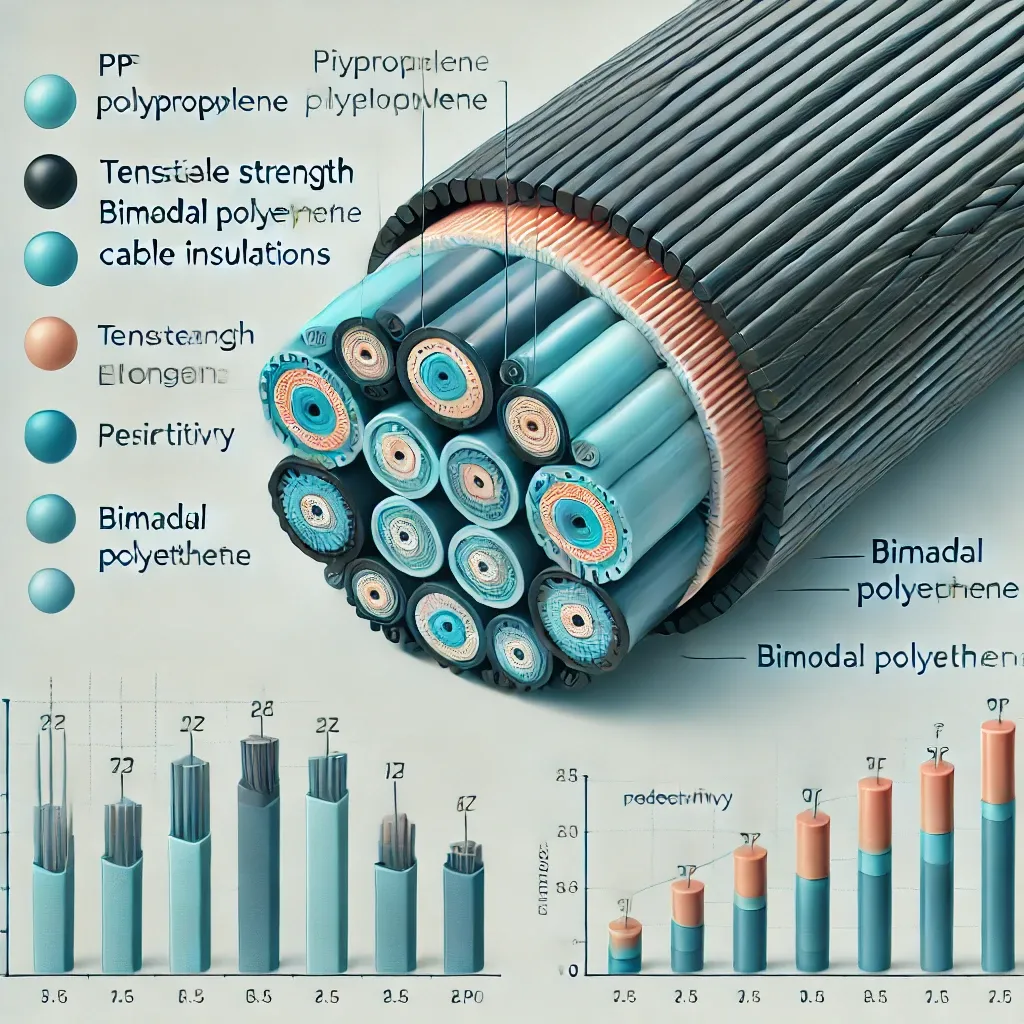Exploring the Mechanical and Dielectric Properties of Polypropylene and Bimodal Polyethylene Blends for Cable Insulation
Introduction
In the ever-evolving field of cable insulation materials, traditional cross-linked polyethylene (XLPE) has long served as the industry standard for medium and low-voltage applications. However, XLPE's shortcomings—including high energy consumption during production and limited recyclability—have encouraged researchers to seek out more sustainable alternatives.
Polypropylene (PP) and bimodal polyethylene (BPE) are two such candidates. Individually, each offers unique advantages: PP boasts excellent dielectric strength and thermal stability, while BPE provides superior mechanical flexibility and processability. This study investigates the performance of various PP/BPE blend ratios, aiming to identify the optimal composition for eco-friendly cable insulation.
1. Objective and Methodology
The objective of the study is to evaluate the mechanical and dielectric performance of non-crosslinked PP/BPE blends with varying mass ratios. The experimental process includes:
Preparing blend samples using melt mixing
Observing the microstructure with polarized optical microscopy
Conducting impact and tensile tests
Measuring dielectric properties including volume resistivity, relative permittivity, and dielectric loss factor
Blend Ratios Examined
Seven different mass ratios of PP to BPE were evaluated:
10% PP / 90% BPE
20% PP / 80% BPE
30% PP / 70% BPE
40% PP / 60% BPE
50% PP / 50% BPE
60% PP / 40% BPE
70% PP / 30% BPE
All samples were stabilized using 1% antioxidant to ensure thermal and oxidative resistance during processing.
2. Microstructural Observation
Polarized light microscopy revealed the spherulite formation and crystalline structure of both pure PP and the 30% PP / 70% BPE blend.
Pure PP formed large, well-defined spherulites during isothermal crystallization at 140°C.
The 30% PP / 70% BPE blend showed a denser crystalline structure with uniform dispersion, suggesting good compatibility between the two polymers.
This dense morphology contributes to improved mechanical performance and stable dielectric behavior in the blends.
3. Mechanical Properties
3.1 Impact Resistance
The impact strength of the PP/BPE blends was evaluated using notched samples and a pendulum impact tester. The results demonstrated a clear brittle-to-tough transition at the 30% PP / 70% BPE composition.
| Blend Ratio | Complete Fracture | Partial Fracture | No Fracture |
|---|---|---|---|
| 10% PP / 90% BPE | 0 | 0 | 6 |
| 30% PP / 70% BPE | 0 | 3 | 3 |
| 50% PP / 50% BPE | 6 | 0 | 0 |
As BPE content decreases, the material becomes more brittle, indicating that BPE is the primary contributor to impact toughness.
Conclusion: The 30% PP / 70% BPE blend marks the transition point, balancing toughness and stiffness.
3.2 Tensile Properties
Tensile tests were conducted at a constant rate of 10 mm/min to analyze stress-strain behavior.
| Property | Trend with PP Increase |
|---|---|
| Elastic Modulus | Increases |
| Tensile Strength | Increases |
| Elongation at Break | Increases |
| Fracture Energy | Increases |
While higher PP content improves strength and stiffness, it also reduces material flexibility. Excessive PP (above 40%) makes the composite difficult to bend, limiting its suitability for cable applications that require coiling or vertical installation.
Conclusion: The 30% PP / 70% BPE blend offers mechanical properties comparable to or better than XLPE, while maintaining adequate flexibility.
4. Dielectric Properties
4.1 Volume Resistivity
All blends exhibited excellent insulation performance, with volume resistivity remaining around 10¹⁴ Ω·m—similar to or better than XLPE.
| Blend Ratio | Volume Resistivity (Ω·m) |
|---|---|
| BPE (pure) | 4.0 × 10¹⁴ |
| 30% PP / 70% BPE | 2.4 × 10¹⁴ |
| 50% PP / 50% BPE | 7.3 × 10¹⁴ |
| PP (pure) | 4.4 × 10¹⁴ |
| XLPE (standard) | ≥ 1.0 × 10¹⁴ |
The variation in resistivity is largely attributed to differences in crystallinity and potential impurities introduced during processing.
4.2 Relative Permittivity and Dielectric Loss
Both properties were tested under 50 Hz AC conditions.
| Blend Ratio | Relative Permittivity | Dielectric Loss (×10⁻⁴) |
|---|---|---|
| BPE | 2.07 | 0.53 |
| 30% PP / 70% BPE | 2.12 | 2.79 |
| 50% PP / 50% BPE | 2.16 | 3.43 |
| PP | 2.12 | 2.03 |
| XLPE | ≤2.35 | ≤5 |
Conclusion: All blends meet the dielectric requirements for medium and low-voltage insulation. Minor variations are attributed to impurities or crystallinity, but remain within acceptable ranges.
5. Discussion
The data reveal a clear trend:
Higher PP content increases tensile strength and resistivity but decreases impact resistance and flexibility.
Higher BPE content enhances toughness and processability but may lower the upper service temperature.
The 30% PP / 70% BPE blend emerges as the optimal formulation, striking a balance between mechanical performance, electrical reliability, and process efficiency. It demonstrates superior compatibility, making it a strong alternative to XLPE for future non-crosslinked cable insulation systems.
Conclusion
This research confirms that PP/BPE blends offer a promising path forward for developing recyclable, environmentally friendly cable insulation. The key findings include:
A 30% PP / 70% BPE ratio delivers the best balance between mechanical strength and electrical performance.
The blend maintains comparable dielectric properties to XLPE while surpassing it in certain mechanical metrics.
The microstructure analysis confirms good dispersion and crystallinity, which directly support the material's durability and insulation performance.
This blend formulation holds potential for commercial use in medium and low-voltage power cables, aligning with global trends toward sustainable materials and green manufacturing.
Keywords
Polypropylene (PP)
Bimodal Polyethylene (BPE)
Melt Blending
Cable Insulation Materials
Dielectric Properties
Mechanical Performance
Eco-friendly Polymers
References
Cao Weikang, Xu Xin (2024). Mechanical and Dielectric Properties with Different Mass Ratio of PP and BPE. Wire & Cable, No. 4, 2024. DOI: 10.16105/j.dxdl.1672-6901.202404002
GB/T 13022—1991: Plastic Film – Tensile Properties Testing Method
IEEE Transactions on Dielectrics and Electrical Insulation.Source: JianYunCable

Comments
Post a Comment